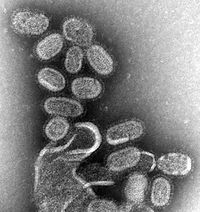
Photo from wikipedia
Abstract Background Viral infections are often treated with empiric antibiotics due to suspected bacterial coinfections, leading to antibiotic overuse. We aimed to describe antibiotic resistance (ABR) trends and their association… Click to show full abstract
Abstract Background Viral infections are often treated with empiric antibiotics due to suspected bacterial coinfections, leading to antibiotic overuse. We aimed to describe antibiotic resistance (ABR) trends and their association with the influenza season in ambulatory and inpatient settings in the United States. Methods We used the BD Insights Research Database to evaluate antibiotic susceptibility profiles in 30-day nonduplicate bacterial isolates collected from patients >17 years old at 257 US healthcare institutions from 2011 to 2019. We investigated ABR in Gram-positive (Staphylococcus aureus and Streptococcus pneumoniae) and Gram-negative (Enterobacterales [ENT], Pseudomonas aeruginosa [PSA], and Acinetobacter baumannii spp [ACB]) bacteria expressed as the proportion of isolates not susceptible ([NS], intermediate or resistant) and resistance per 100 admissions (inpatients only). Antibiotics included carbapenems (Carb), fluoroquinolones (FQ), macrolides, penicillin, extended-spectrum cephalosporins (ESC), and methicillin. Generalized estimating equations models were used to evaluate monthly trends in ABR outcomes and associations with community influenza rates. Results We identified 8 250 860 nonduplicate pathogens, including 154 841 Gram-negative Carb-NS, 1 502 796 Gram-negative FQ-NS, 498 012 methicillin-resistant S aureus (MRSA), and 44 131 NS S pneumoniae. All S pneumoniae rates per 100 admissions (macrolide-, penicillin-, and ESC-NS) were associated with influenza rates. Respiratory, but not nonrespiratory, MRSA was also associated with influenza. For Gram-negative pathogens, influenza rates were associated with the percentage of FQ-NS ENT, FQ-NS PSA, and Carb-NS ACB. Conclusions Our study showed expected increases in rates of ABR Gram-positive and identified small but surprising increases in ABR Gram-negative pathogens associated with influenza activity. These insights may help inform antimicrobial stewardship initiatives.
Journal Title: Open Forum Infectious Diseases
Year Published: 2022
Link to full text (if available)
Share on Social Media: Sign Up to like & get
recommendations!